@Finn350
it could be related to sonoma, but:
first, update your os and then restart your computer. if that fails proceed to the following steps:
1. Delete all folders that start with “CC_LIBRARIES_PANEL_EXTENSION_xx_xx_xx” in this location:
WIN: C:\Program Files (x86)\Common Files\Adobe\CEP\extensions
MAC: Macintosh HD ▸ Library ▸ Application Support ▸ Adobe ▸ CEP -> extensions
2. Follow the steps of Solution 2 in this article: https://helpx.adobe.com/creative-cloud/kb/libraries-panel-not-working.html
Before trying the steps — please, make sure you killed the CCLibraries process in Task Manager / Activity Monitor, as well as you have quit all Adobe related products.
You need to Allow / Whitelist below ports.
Adobe Ports/Host combinations
ccmdl.adobe.com:80
swupmf.adobe.com:80
swupdl.adobe.com:80
https://na1mbls.licenses.adobe.com
https://ims-na1.adobelogin.com
https://adobeid-na1.services.adobe.com
https://na1r.services.adobe.com
http://activate.adobe.com
https://activate.adobe.com
http://adobe.activate.com
https://adobe.activate.com
ccmdls.adobe.com:443
ims-na1.adobelogin.com:443
na1r.services.adobe.com:443
prod-rel-ffc-ccm.oobesaas.adobe.com:443
lm.licenses.adobe.com:443
www-du1.adobe.com
- Компьютеры
- Cancel
Все советуют просто заблокировать программам Adobe CS5 (Master Collection) доступ в сеть интернет. Но как это сделать, никто не пишет. Обычный брандмауэр отказывается предупреждать меня о том, что Адоб общается со своим сервером без моего разрешения. Ставить отдельный файрвол – тоже дополнительные заботы с подбором программы, настройками и прочим. В общем из советов в интернете все верно сказано, но детально и пошагово не написано ничего.
Когда мне потребовалось все же решить окончательно эту проблему, я разобрался самостоятельно и сейчас опишу вам все по пунктам. Вопрос решается тонкой настройкой брандмауэра windows (у меня win7):
1. Заходим в «Панель управления/Брандмауэр Windows/Дополнительные параметры»
2. В появившемся окне в левом столбце (фрейме) выбираем «Правила для исходящего подключения».
3. В правом столбце (фрейм «Действия») жмем «Создать правило». Появляется окно «Мастер создания правила для нового исходящего подключения».
4. В окне мастера настраиваем следующее: «Правило какого типа вы хотите создать?» ставим переключатель на пункт «Для программы».
5. «Применять это правило ко всем программам или к определенной программе?», здесь указываем путь к программе, которую блокируем: «%ProgramFiles%\Common Files\Adobe\OOBE\PDApp\core\PDapp.exe»
6. «Укажите действие, которое должно выполняться, когда подключение удовлетворяет указанным условиям». Выбираем «Блокировать подключение».
7. «Для каких профилей применяется правило?». Здесь я считаю необходимо отметить все существующие профили.
8. Далее необходимо задать имя и описание созданного нами правила, для самих же себя. Программа, которую мы заблокировали данным правилом, называется «Adobe application manager». Она первая подключается через интернет при запуске любого приложения.
9. Жмем «Готово»!
Теперь такую же процедуру необходимо проделать для всех продуктов Adobe, которые вы используете. Путь к Adobe Illustrator: «%ProgramFiles%\Adobe\Adobe Illustrator CS5\Support Files\Contents\Windows\Illustrator.exe»,

i Digital Vision./Digital Vision/Getty Images
Certain Adobe software, like Adobe Media Server and Adobe Connect, require an Internet connection to perform critical functions. Windows Firewall, however, enables administrators to block these applications from accessing a corporate domain, a private network or a public hot spot. Companies and institutions can implement Windows Firewall to block unauthorized use of these applications, while home and business users can secure their PCs by preventing certain programs from using the Internet when on a public network.
Automatic Blocking
Step 1
Press «Windows-W,» type «firewall» and then select «Allow an App Through Windows Firewall» from the results.
Step 2
Click «Change Settings.» Locate the appropriate application, such as Adobe Connect or Adobe Media Server, and then deselect the check box to the left of the program.
Step 3
Click «Allow Another App» if Windows Firewall fails to list the software. Choose the appropriate application, click «Add» and follow the instructions in Step 2.
Step 4
Click «OK» to prevent Adobe from connecting to the Internet.
Manual Configuration
Step 1
Press «Windows-W,» type «firewall» and then select «Windows Firewall» from the results.
Step 2
Select «Advanced Settings» from the left pane to open «Windows Firewall With Advanced Security.»
Step 3
Click «Inbound Rules» and then click «New Rule» to open the New Inbound Rule wizard. Click «Port» and then «Next.»
Step 4
Select «TCP,» enter «1935» (without the quotations) into the «Specific Local Ports» field and then click «Next.»
Step 5
Select «Block the Connection» and then click «Next.» Choose whether to disable the port on the corporate domain, a private network or a public network. Click «Next.»
Step 6
Enter a name, such as «Adobe Media Server,» into the «Name» field and then click «Finish.»
Step 7
Create another rule following the same process, except this time select «UDP» when prompted.
Step 8
Select «Outbound Rules» from the left pane, click «New Rule» and follow the on-screen instructions once again to block TCP 1935 and UDP 1935.
References
Writer Bio
Ruri Ranbe has been working as a writer since 2008. She received an A.A. in English literature from Valencia College and is completing a B.S. in computer science at the University of Central Florida. Ranbe also has more than six years of professional information-technology experience, specializing in computer architecture, operating systems, networking, server administration, virtualization and Web design.
It seems like every program available today is constantly phoning home with telemetry data, contacting advertising servers, or just generally making needless connections to the internet. While these connections are not usually malicious in any way, some users want to be in control of how their software connects to the internet.
If you’re using Windows 10, you’ve got a built-in software firewall that allows you to control what programs and services are allowed to connect to the internet!
Depending on your current settings, you may see the occasional connection request after you’ve installed a new program; that’s the firewall creating a new connection rule for your new app.
A lot of people have the mistaken belief that blocking Photoshop in the Windows 10 firewall will allow them to circumvent Adobe’s licensing restrictions, but this is incorrect. Adobe is smarter than that and uses a very different system for managing activations and licensing.
I refuse to help you break the law! Photoshop is great software, and you should pay for using it.
Even if you’ve never seen a firewall message, or even if you don’t know what a firewall is, I’ll show you how you can use it to stop Photoshop from connecting to the internet.
Warning: This process is intended for users who are absolutely certain that they want to block Photoshop from contacting the internet.
This may cause certain Photoshop features to work incorrectly or break completely, so if you’re not entirely certain that this is within your technical abilities and understanding, now is your last chance to back out!
If something goes wrong, we are NOT responsible for any issues that arise!
Table of Contents
- The Quick Guide to Blocking Photoshop In Windows 10 Firewall
- The Detailed Guide to Block Photoshop In Firewall (Windows 10)
- Step 1: Open Your Firewall Settings
- Step 2: Time To Advance
- Step 3: Outbound Rules
- Step 4: Create A New Rule
- A Final Word
The Quick Guide to Blocking Photoshop In Windows 10 Firewall
If you’re already familiar with the Windows 10 firewall, here’s a quick guide to creating a new rule that will block Photoshop.
- Step 1: Open the Windows Defender Firewall Control Panel.
- Step 2: Click Advanced Settings and give the administrator permission.
- Step 3: Click Outbound Rules, then click Create new rule…
- Step 4: Follow the wizard settings to block Photoshop
Of course, I’d bet that many of you have no idea what any of that means, so I’ll explain things in more detail below with some handy screenshots and other tips.
The Detailed Guide to Block Photoshop In Firewall (Windows 10)
Remember, this process may cause Photoshop to stop working properly, so make sure that you’re entirely committed to this project before continuing.
Step 1: Open Your Firewall Settings
To get started, you’ll need to open the Windows Defender Firewall control panel. Click the Start button, and type firewall to search your computer for matches. You should see an entry similar to the one below. Click to open it.
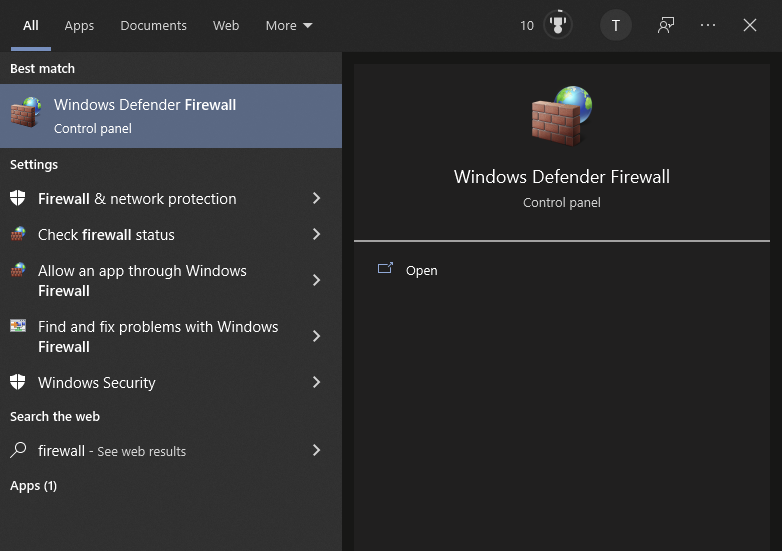
As you’d expect, this will open the Windows Defender Firewall control panel, displaying all of your current network firewall settings.
Step 2: Time To Advance
On the left side of the panel, click the Advanced settings link to get under the hood and see all the actual rules that your firewall is currently using.
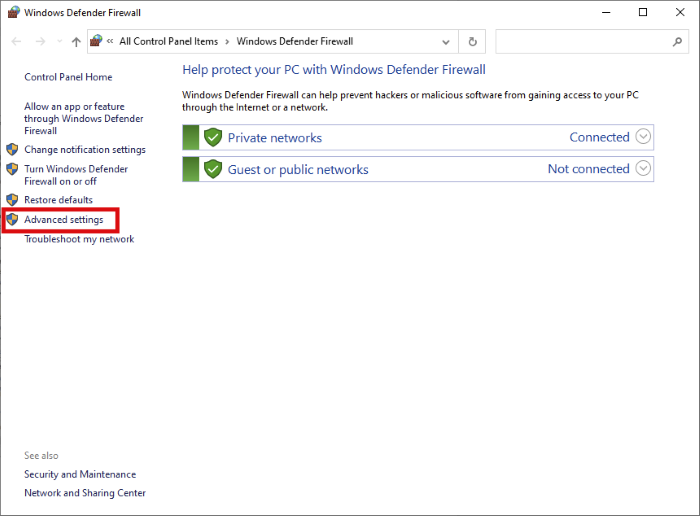
You will have to provide administrator permission in order to edit and change these rules. If you deny permission, the process will fail.
Step 3: Outbound Rules
Your software firewall is divided into several sections, but we are only concerned about Outbound Rules. These rules define which programs are allowed to create new connections from your computer to another computer using your internet service.
To block Photoshop from making new connections, we’ll have to create a new Outbound Rule.
In the left-most pane of the firewall window, click Outbound Rules (shown below).
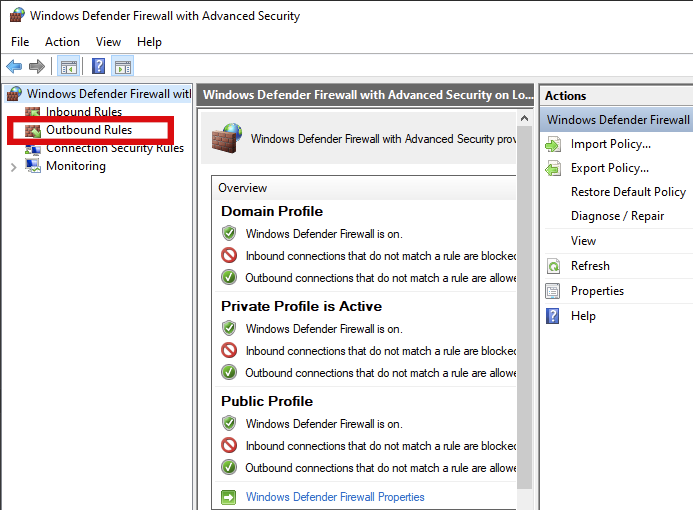
The view will update, showing you a huge list of the existing Outbound Rules.
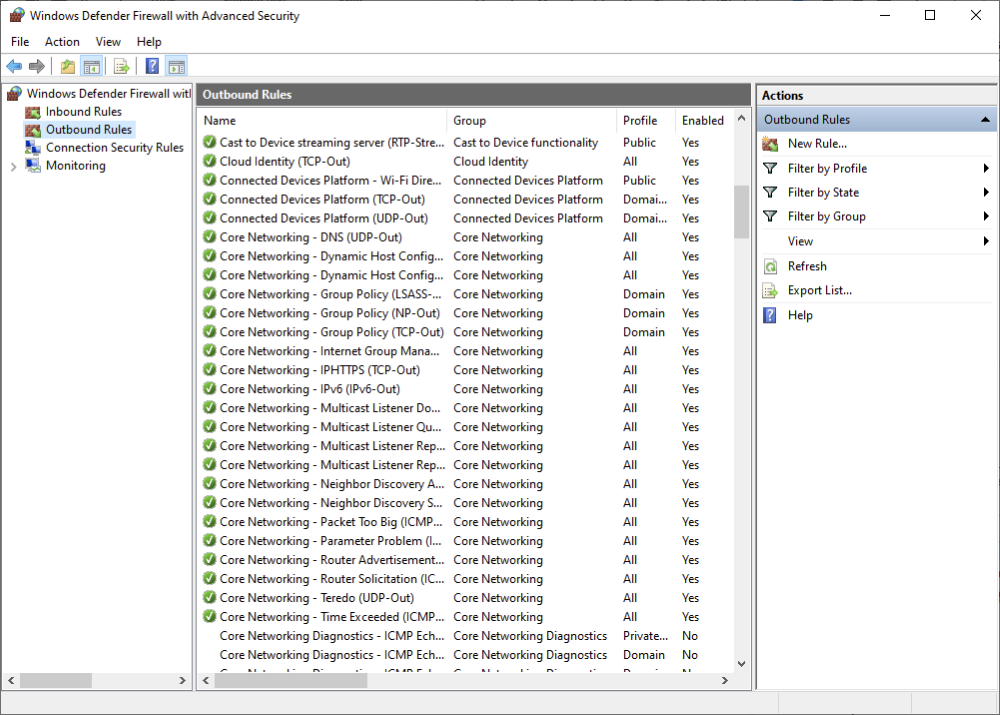
Switching to the right-most pane, click the New Rule… link to start the New Outbound Rule Wizard, which will guide you through the steps of creating a new rule to block Photoshop.
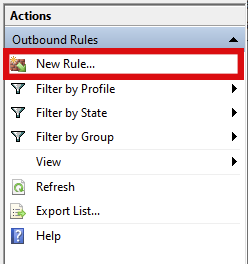
Step 4: Create A New Rule
Despite the overwhelming amount of information in the last few steps, the New Outbound Rule Wizard is actually very easy to use.
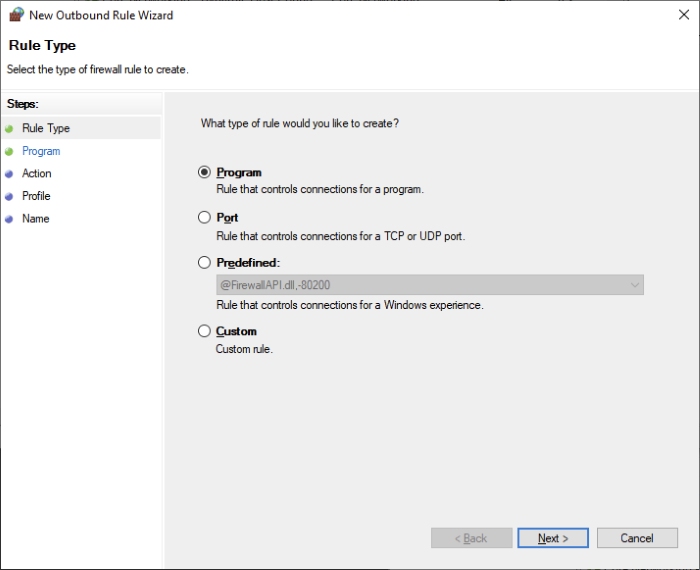
By default, it should be set to Program, which is what we’ll need to use to block Photoshop.
Click the Next button to proceed.
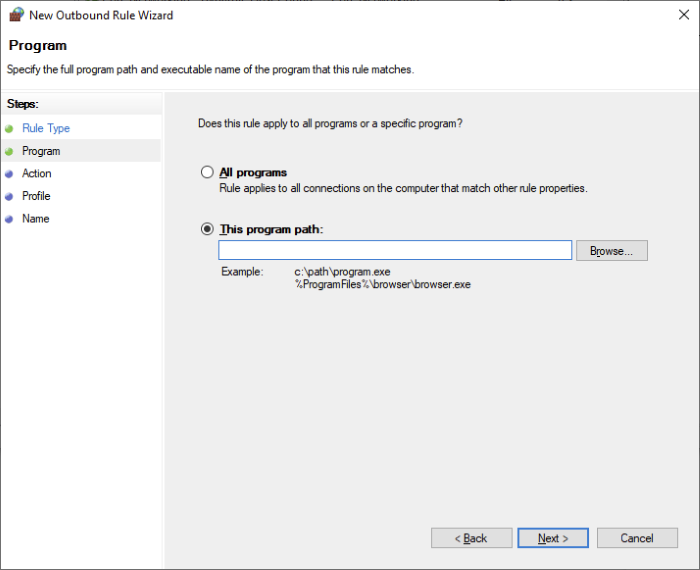
Now it’s time to define which program we want this new rule to apply to. Click the Browse button, and navigate to find your current version of Photoshop.
By default, the Photoshop executable file is located here (the year will change depending on which version of Photoshop you want to block):
C:\ > Program Files > Adobe > Adobe Photoshop 2022 > Photoshop.exe
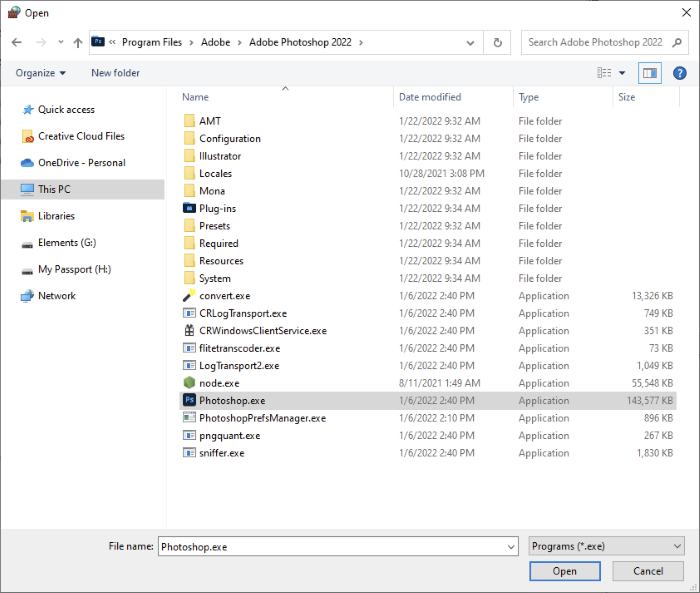
Select the correct file, and click the Open button. The full path will be entered into the appropriate location.
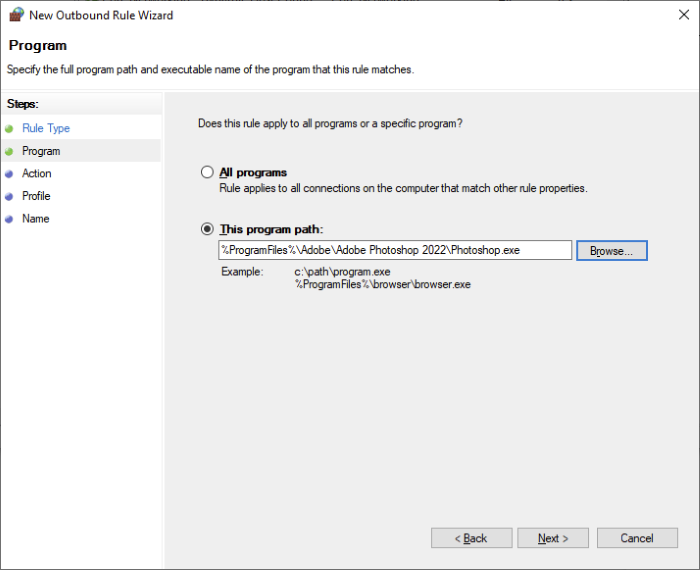
Click the Next button to proceed.
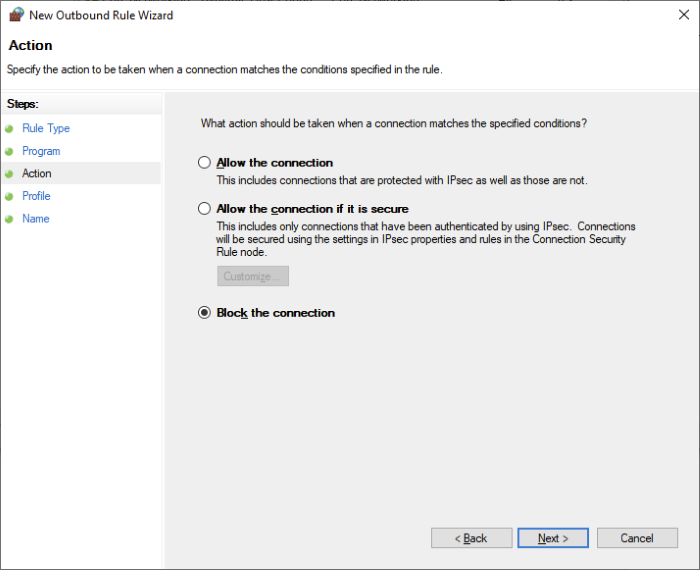
The default setting should be Block the connection. If it’s not selected automatically, select it yourself, and then click the Next button again.
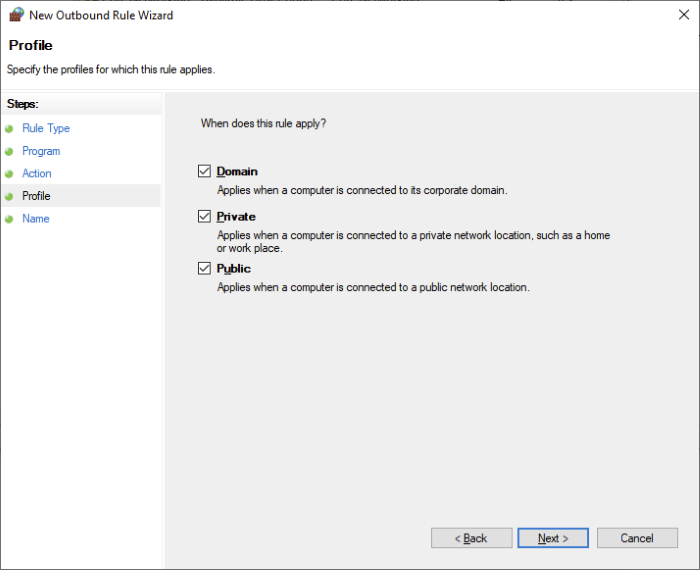
Ensure that all three boxes are checked, and click Next.
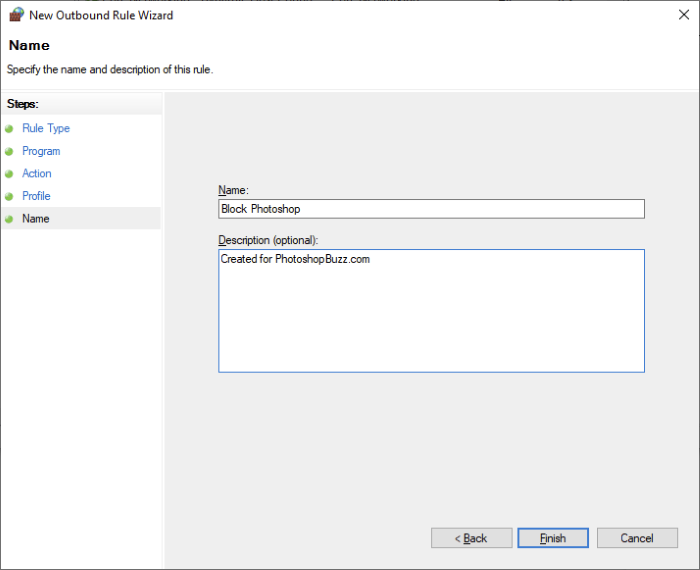
Give your new rule a descriptive name so you can find it later, in case you need to remove it.
To finalize your rule, click the Finish button.
That’s all there is to it! You can use the same process to block any program that you want in the Windows 10 firewall.
A Final Word
Messing around with firewall settings can be very dangerous. While Windows is often poorly-regarded for its information security, the software firewall plays a large role in keeping you safe online.
Be extremely cautious when adding, editing, or removing rules, as a small accidental change could leave your computer wide open to the worst of what the web has to offer.
Photoshop uses its internet connection to sync files, provide tutorial content, and many other useful features that are worth leaving intact. When in doubt, leave the firewall alone!
Thomas started his Photoshop career way back in 2000. After exploring Photoshop 5.5 in a high school computer lab, he developed an enduring passion for photography, design, and technology that carried him through a Bachelor of Design degree and into the wild world of tech startups.